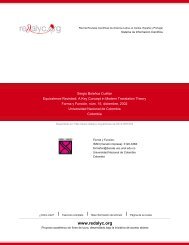realismo mágico e ficção cyberpunk no romance de ... - RedALyC
realismo mágico e ficção cyberpunk no romance de ... - RedALyC
realismo mágico e ficção cyberpunk no romance de ... - RedALyC
You also want an ePaper? Increase the reach of your titles
YUMPU automatically turns print PDFs into web optimized ePapers that Google loves.
O próprio e o alheio em el <strong>de</strong>lirio <strong>de</strong> turing: <strong>realismo</strong> <strong>mágico</strong> e <strong>ficção</strong><br />
<strong>cyberpunk</strong> <strong>no</strong> <strong>romance</strong> <strong>de</strong> edmundo paz soldán<br />
Rodolfo Rorato Lon<strong>de</strong>ro 1<br />
Abstract: The objective of this paper is to analyze the <strong>no</strong>vel El <strong>de</strong>lirio <strong>de</strong><br />
Turing (2003), by Bolivian writer Edmundo Paz Soldán, mainly in it<br />
relationship with the <strong>cyberpunk</strong> fiction, subgenre of science fiction appeared<br />
originally in the North American context of 1980's. This relationship appears,<br />
at once, in the epigraphs of the work, where a <strong>cyberpunk</strong> writer (Neal<br />
Stephenson) is quoted: actually, this writer's two works, S<strong>no</strong>w Crash (1992)<br />
and Crypto<strong>no</strong>micon (1999), appear as intertexts in El <strong>de</strong>lirio <strong>de</strong> Turing. But<br />
Paz Soldán, as member of McOndo generation – a globalizated parody of<br />
García Márquez's Macondo –, also maintain an intense dialogue with their<br />
Latin-American antece<strong>de</strong>nts, the writers of magic realism. It is in that<br />
collision between the own and the alien (Carvalhal), between Latin and North<br />
American literary references, that we will un<strong>de</strong>rstand Paz Soldán's work.<br />
key words: Cyberpunk fiction; Magic realism; Comparative literature;<br />
Introdução<br />
As palavras <strong>de</strong> Mario Vargas Llosa na contracapa da edição argentina <strong>de</strong> El<br />
<strong>de</strong>lirio <strong>de</strong> Turing (2003) são animadoras: “Edmundo Paz Soldán é um dos<br />
melhores escritores da <strong>no</strong>va geração”. Porém, como pensar nessas palavras<br />
ditas pelo mestre perua<strong>no</strong> do <strong>realismo</strong> <strong>mágico</strong> ao consi<strong>de</strong>rar quem elas<br />
elogiam, um escritor bolivia<strong>no</strong> que tem como referência não só a <strong>ficção</strong><br />
científica em geral (Brown, 2007), mas também uma <strong>de</strong> suas tendências<br />
contemporâneas, conhecida como <strong>cyberpunk</strong> – uma das epígrafes <strong>de</strong> El<br />
<strong>de</strong>lirio, por exemplo, é citada <strong>de</strong> S<strong>no</strong>w Crash (1992), do escritor <strong>cyberpunk</strong><br />
Neal Stephenson? Temos então uma antítese, pelo me<strong>no</strong>s aparentemente,<br />
entre as referências populares e folclóricas <strong>de</strong> quem elogia e as referências<br />
tec<strong>no</strong>lógicas <strong>de</strong> quem é elogiado.<br />
1 Universida<strong>de</strong> Estadual do Centro- Oeste, Brasil

















